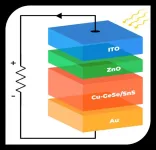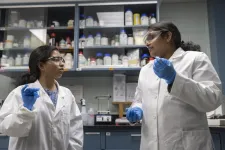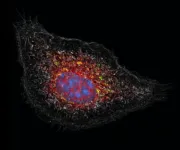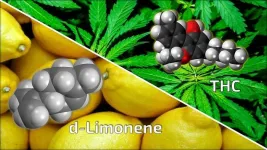(Press-News.org) Researchers from Lehigh University have developed a material that demonstrates the potential for drastically increasing the efficiency of solar panels.
A prototype using the material as the active layer in a solar cell exhibits an average photovoltaic absorption of 80%, a high generation rate of photoexcited carriers, and an external quantum efficiency (EQE) up to an unprecedented 190%—a measure that far exceeds the theoretical Shockley-Queisser efficiency limit for silicon-based materials and pushes the field of quantum materials for photovoltaics to new heights.
“This work represents a significant leap forward in our understanding and development of sustainable energy solutions, highlighting innovative approaches that could redefine solar energy efficiency and accessibility in the near future,” said Chinedu Ekuma, professor of physics, who published a paper on the development of the material with Lehigh doctoral student Srihari Kastuar in the journal Science Advances.
The material’s efficiency leap is attributable largely to its distinctive “intermediate band states,” specific energy levels that are positioned within the material's electronic structure in a way that makes them ideal for solar energy conversion.
These states have energy levels within the optimal subband gaps—energy ranges where the material can efficiently absorb sunlight and produce charge carriers—of around 0.78 and 1.26 electron volts.
In addition, the material performs especially well with high levels of absorption in the infrared and visible regions of the electromagnetic spectrum.
In traditional solar cells, the maximum EQE is 100%, representing the generation and collection of one electron for each photon absorbed from sunlight. However, some advanced materials and configurations developed over the past several years have demonstrated the capability of generating and collecting more than one electron from high-energy photons, representing an EQE of over 100%.
While such Multiple Exciton Generation (MEG) materials are yet to be broadly commercialized, they hold the potential to greatly increase the efficiency of solar power systems. In the Lehigh-developed material, the intermediate band states enable the capture of photon energy that is lost by traditional solar cells, including through reflection and the production of heat.
The researchers developed the novel material by taking advantage of “van der Waals gaps,” atomically small gaps between layered two-dimensional materials. These gaps can confine molecules or ions, and materials scientists commonly use them to insert, or “intercalate,” other elements to tune material properties.
To develop their novel material, the Lehigh researchers inserted atoms of zerovalent copper between layers of a two-dimensional material made of germanium selenide (GeSe) and tin sulfide (SnS).
Ekuma, an expert in computational condensed matter physics, developed the prototype as a proof of concept after extensive computer modeling of the system demonstrated theoretical promise.
“Its rapid response and enhanced efficiency strongly indicate the potential of Cu-intercalated GeSe/SnS as a quantum material for use in advanced photovoltaic applications, offering an avenue for efficiency improvements in solar energy conversion,” he said. “It’s a promising candidate for the development of next-generation, high-efficient solar cells, which will play a crucial role in addressing global energy needs.”
Although integrating the newly designed quantum material into current solar energy systems will need further research and development, Ekuma points out that the experimental technique used to create these materials is already highly advanced. Scientists have, over time, mastered a method that precisely inserts atoms, ions, and molecules into materials.
The research was funded in part by a grant from the U.S. Department of Energy.
END
New quantum material promises over 190% quantum efficiency in solar cells
It’s a promising candidate for the development of next-generation, high-efficient solar cells, which will play a crucial role in addressing global energy needs
2024-04-10
ELSE PRESS RELEASES FROM THIS DATE:
AI powered “digital twin” models the infant microbiome
2024-04-10
The gut microbiome has a profound impact on the health and development of infants. Research shows that dysbiosis—or imbalances in the microbial community—is associated with gastrointestinal diseases and neurodevelopmental deficits. Understanding how gut bacteria interact, and how these interactions may lead to some of these problems, however, is difficult and time consuming through traditional laboratory experiments.
Researchers at the University of Chicago have developed a new generative artificial intelligence (AI) tool that models the infant microbiome. This “digital ...
World-first “Cybercrime Index” ranks countries by cybercrime threat level
2024-04-10
Following three years of intensive research, an international team of researchers have compiled the first ever ‘World Cybercrime Index’, which identifies the globe’s key cybercrime hotspots by ranking the most significant sources of cybercrime at a national level.
The Index, published today in the journal PLOS ONE, shows that a relatively small number of countries house the greatest cybercriminal threat. Russia tops the list, followed by Ukraine, China, the USA, Nigeria, and Romania. The UK comes in at number eight.
Co-author of the study, Dr Miranda Bruce from the ...
A study in Science Advances suggests liquid biopsy could detect and monitor aggressive small cell lung cancer
2024-04-10
A new lab assay developed by researchers at Fred Hutch Cancer Center could make diagnosis and treatment of small-cell lung cancer and non-small cell lung cancer easier.
The blood-based test, also called a “liquid biopsy,” can detect differences between types of lung cancer by examining patterns in cell-free tumor DNA in blood samples. It’s a desirable option for detecting small-cell lung cancer (SCLC) as standard needle biopsies fail due the number of smaller tumors typically present and the variety of tumor subtypes that indicate different treatment pathways.
“There ...
New drug prevents flu-related inflammation and lung damage
2024-04-10
(MEMPHIS, Tenn. – April 10, 2024) Infection with the influenza virus leads to lung injury through inflammation over-activation that causes collateral damage to cells required for breathing. Such damage can be life-threatening, but scientists have a new preventative treatment. A team from St. Jude Children’s Research Hospital, University of Houston, Tufts University School of Medicine and Fox Chase Cancer Center created a drug that can prevent flu-induced lung injury. In a mouse model, the ...
Taking on the global challenge of hidden hunger
2024-04-10
COLUMBIA, Mo. — More than 2 billion people suffer from hidden hunger, a form of malnutrition where individuals lack essential micronutrients — like vitamins and minerals — even though they consume what appears to be an adequate amount of calories.
University of Missouri researcher Kiruba Krishnaswamy is focused on tackling this global challenge. She recently received a five-year, $532,000 Early Career Development (CAREER) award from the National Science Foundation (NSF) — the NSF’s most prestigious award for early-career faculty — in support of her project titled ...
Engineers making a better, more profitable grid for distributing solar power
2024-04-10
AMES, Iowa – If you’re the Midcontinent Independent System Operator – the organization that manages the flow of high-voltage electricity across a central stripe of the U.S. and Canada, from Manitoba, Michigan and Minnesota through Iowa and all the way to Louisiana – you want energy supplies to meet the energy demands of 45 million people.
“We make sure the right amount of electricity is generated and transmitted to our member utilities,” says the regional grid operator’s website.
Balancing power supply and demand is complicated these days. Electricity is no longer exclusively generated by power plants using coal- or natural ...
Initiative increases awareness of the threats posed by light pollution to the global ocean
2024-04-10
Scientists, policy makers, and marine and environmental professionals across the world are being encouraged to sign up to a new initiative highlighting some of the global threats posed by light pollution.
The Global Ocean Artificial Light at Night Network (GOALANN) has been launched today at the United Nations Ocean Decade Conference in Barcelona.
It has been established by ecologists, oceanographers and social scientists who have spent more than a decade studying the impact of light pollution on the ocean, and the many species living in or near it.
The GOALANN network aims to expand on the impact of that work, unifying research groups ...
How the body switches out of “fight” mode
2024-04-10
Joint press release of Charité and Uniklinikum Erlangen
Cortisone and other related glucocorticoids are extremely effective at curbing excessive immune reactions. But previously, astonishingly little was known about how they exactly do that. A team of researchers from Charité – Universitätsmedizin Berlin, Uniklinikum Erlangen and Ulm University have now explored the molecular mechanism of action in greater detail. As the researchers report in the journal Nature,* glucocorticoids reprogram ...
Physicists discover a novel quantum state in an elemental solid
2024-04-10
Physicists have observed a novel quantum effect termed “hybrid topology” in a crystalline material. This finding opens up a new range of possibilities for the development of efficient materials and technologies for next-generation quantum science and engineering.
The finding, published in the April 10th issue of Nature, came when Princeton scientists discovered that an elemental solid crystal made of arsenic (As) atoms hosts a never-before-observed form of topological quantum behavior. They were able to explore and image this ...
Researchers show chemical found naturally in cannabis may reduce anxiety-inducing effects of THC
2024-04-10
FOR IMMEDIATE RELEASE
A Johns Hopkins Medicine-led research team has added to evidence that a chemical found naturally in cannabis (also known as marijuana) can — in the right amounts — lessen the anxiety-inducing effects of tetrahydrocannabinol (THC), the primary psychoactive sister chemical found in cannabis. The finding has the potential to advance the medicinal use of THC, and reduce the risks of its recreational use in some people.
The substance, called d-limonene, is one of the most abundant terpenes, or essential oils, in the cannabis plant, and has shown promise in rodent studies in reducing anxiety behaviors. However, there has ...
LAST 30 PRESS RELEASES:
The (metabolic) cost of life
CFRI special issue call for papers: New Frontiers in Sustainable Finance
HKU Engineering scholar demonstrates the smallest all-printed infrared photodetectors to date
Precision empowerment for brain "eavesdropping": CAS team develops triple-electrode integrated functional electrode for simultaneous monitoring of neural signals and chemical transmitters during sleep
Single-capillary endothelial dysfunction resolved by optoacoustic mesoscopy
HKU three research projects named among ‘Top 10 Innovation & Technology News in Hong Kong 2025’ showcasing excellence in research and technology transfer
NLRSeek: A reannotation-based pipeline for mining missing NLR genes in sequenced genomes
A strand and whole genome duplication–aware collinear gene identification tool
Light storage in light cages: A revolutionary approach to on-chip quantum memories
Point spread function decoupling in computational fluorescence microscopy
BacPhase: Long-insert paired-end sequencing for bin marker construction and genome phasing
GmWOX1 regulates the mediolateral polarity of compound leaves in soybean
ChargeFabrica: An open-source simulation tool that aims to accelerate search for high performance perovskite solar cells
High levels of ADAR overexpression induce abundant and stochastic off-target RNA editing in rice protoplasts
On-demand upgraded recycling of polyethylene and construction of sustainable multifunctional materials based on the "LEGO" strategy
New "Stomata in-sight" system allows scientists to watch plants breathe in real-time
Anorexia nervosa may result in long-term skeletal muscle impairment
Narrative-based performance reviews deemed fairest by employees
New insights reveal how advanced oxidation can tackle emerging water pollutants
New review shows how biomass can deliver low-carbon gaseous fuels at scale
Climate change is quietly rewriting the world’s nitrogen cycle, with high stakes for food and the environment
Study finds SGLT-2 inhibitors linked to lower risk of diabetic foot nerve damage
Microbes may hold the key to brain evolution
Study examines how the last two respiratory pandemics rapidly spread through cities
Gender stereotypes reflect the division of labor between women and men across nations
Orthopedics can play critical role in identifying intimate partner violence
Worms as particle sweepers
Second spider-parasitic mite described in Brazil
January 2026 issues of APA journals feature new research on autism, pediatric anxiety, psychedelic therapy, suicide prevention and more
Private equity acquired more than 500 autism centers over the past decade, new study shows
[Press-News.org] New quantum material promises over 190% quantum efficiency in solar cellsIt’s a promising candidate for the development of next-generation, high-efficient solar cells, which will play a crucial role in addressing global energy needs









